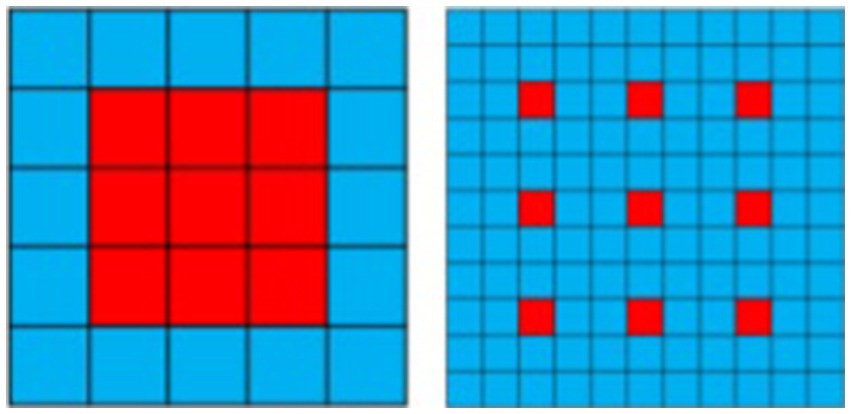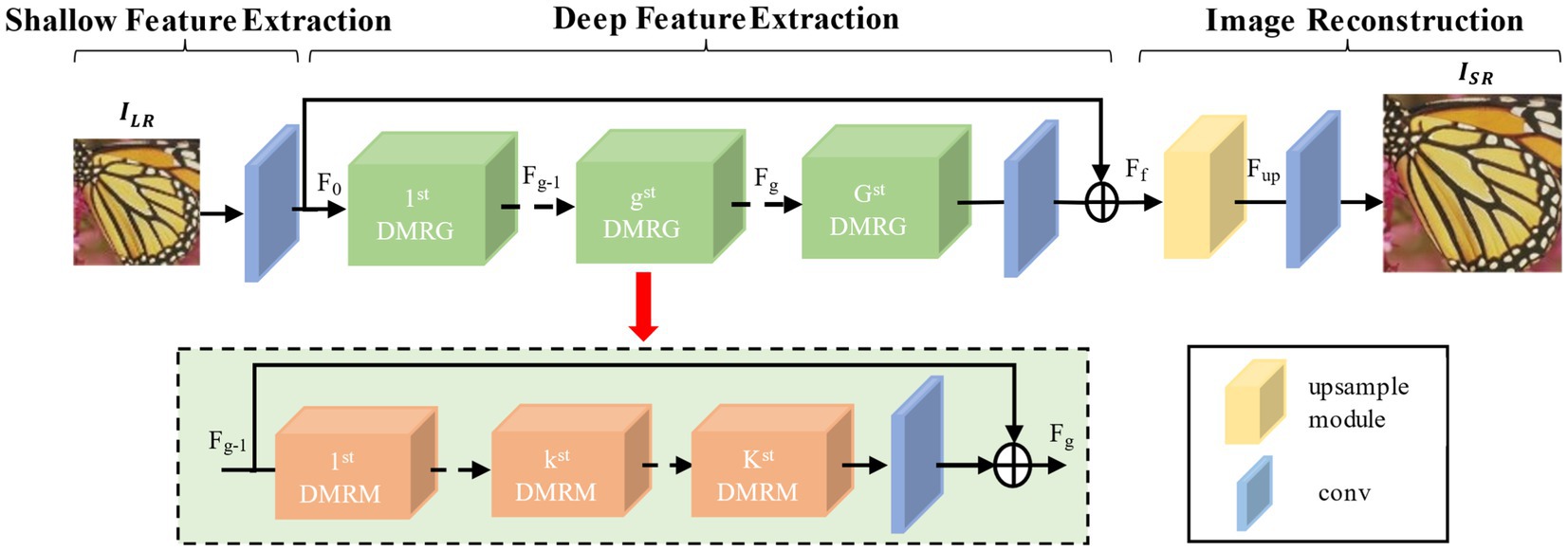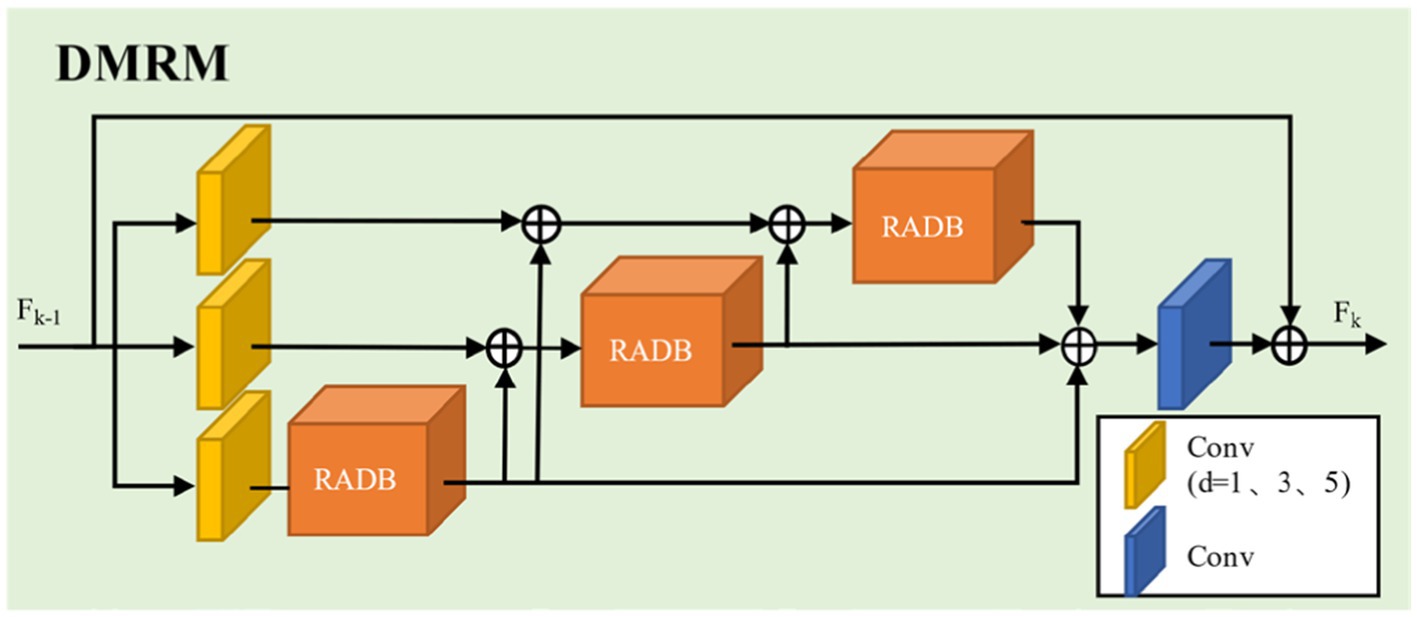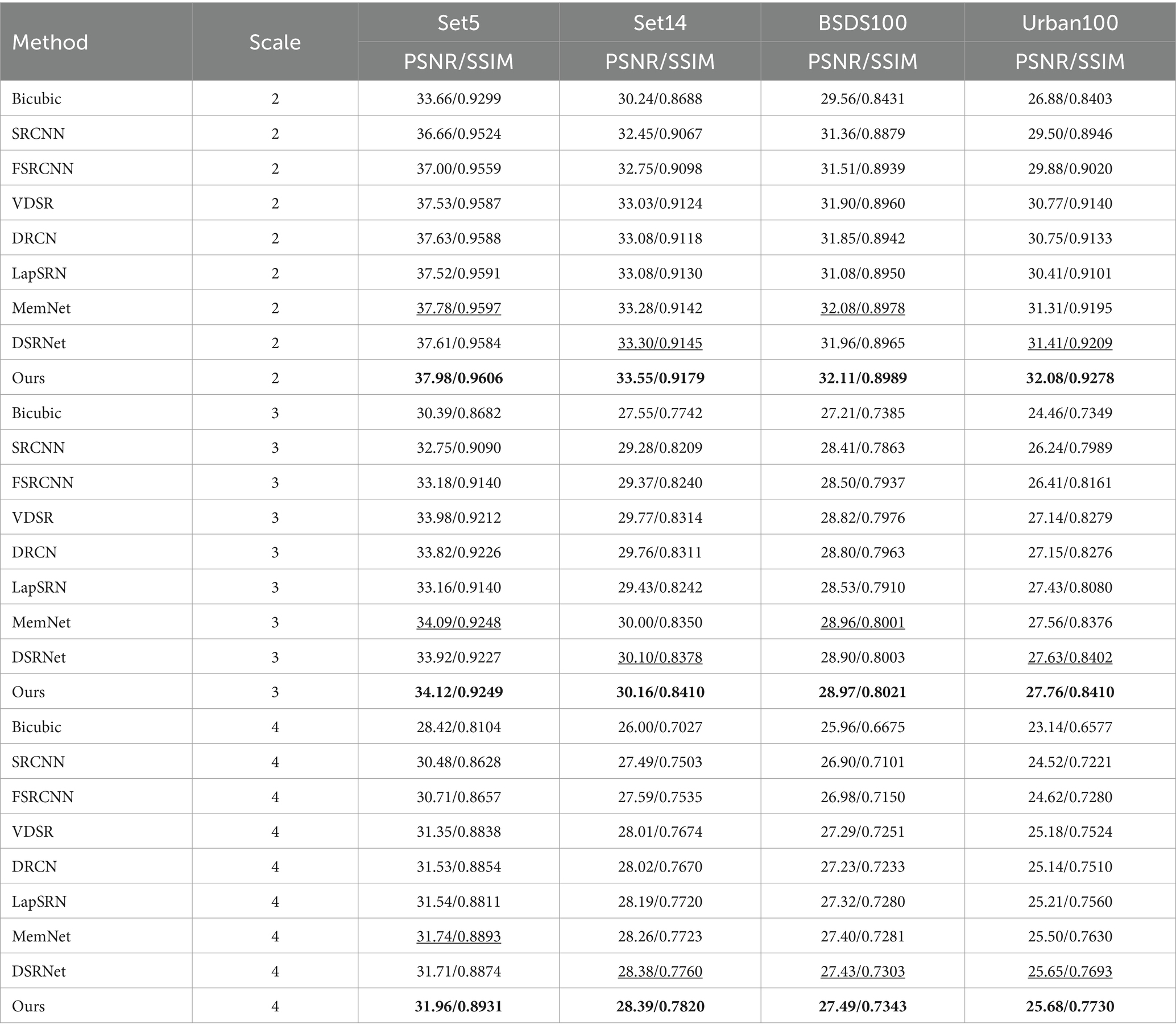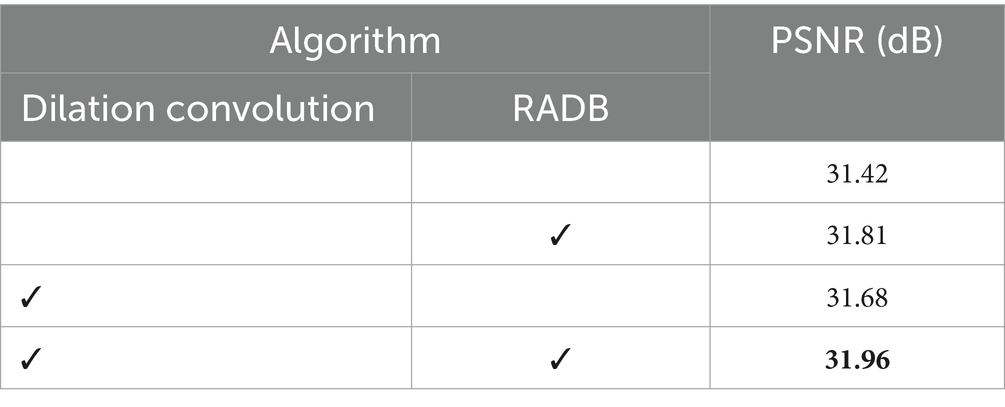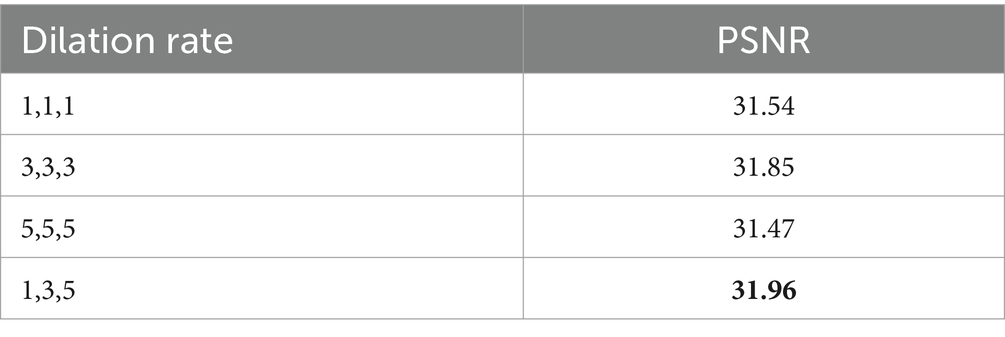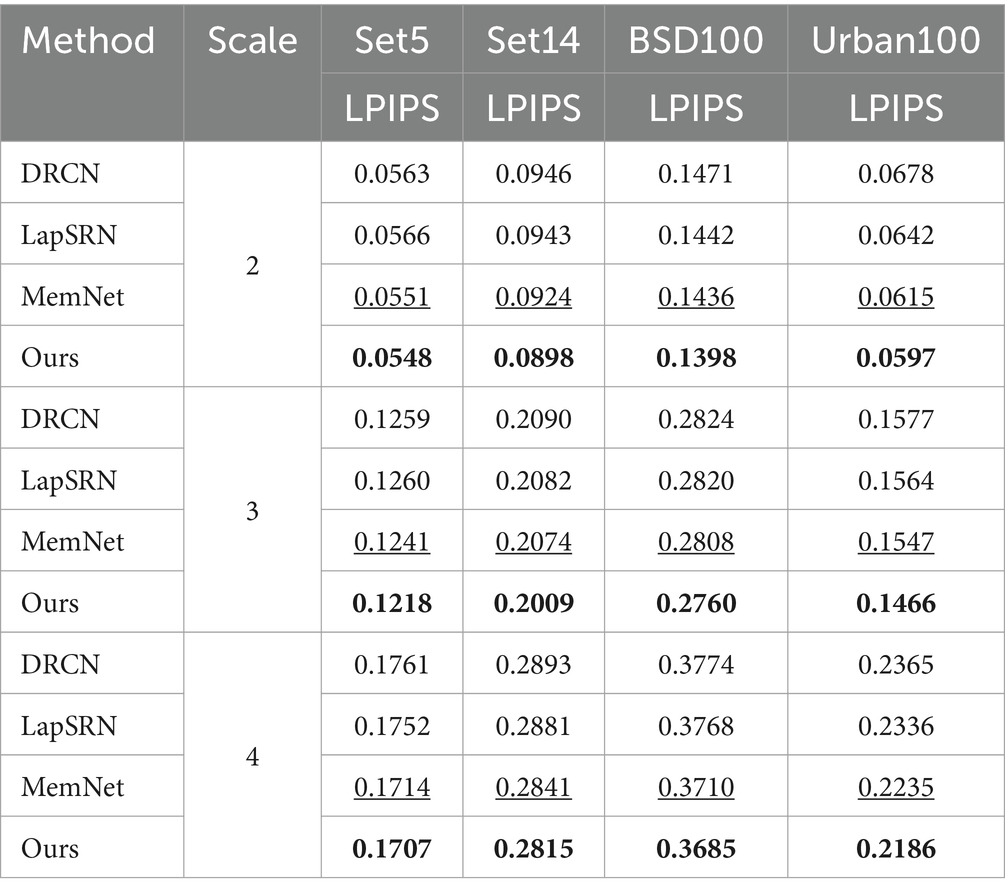- 1School of Information Engineering, Chuzhou Polytechnic, Chuzhou, China
- 2School of Computer, Qinghai Normal University, Xining, China
Aiming at the problems of traditional image super-resolution reconstruction algorithms in the image reconstruction process, such as small receptive field, insufficient multi-scale feature extraction, and easy loss of image feature information, a super-resolution reconstruction algorithm of multi-scale dilated convolution network based on dilated convolution is proposed in this paper. First, the algorithm extracts features from the same input image through the dilated convolution kernels of different receptive fields to obtain feature maps with different scales; then, through the residual attention dense block, further obtain the features of the original low resolution images, local residual connections are added to fuse multi-scale feature information between multiple channels, and residual nested networks and jump connections are used at the same time to speed up deep network convergence and avoid network degradation problems. Finally, deep network extraction features, and it is fused with input features to increase the nonlinear expression ability of the network to enhance the super-resolution reconstruction effect. Experimental results show that compared with Bicubic, SRCNN, ESPCN, VDSR, DRCN, LapSRN, MemNet, and DSRNet algorithms on the Set5, Set14, BSDS100, and Urban100 test sets, the proposed algorithm has improved peak signal-to-noise ratio and structural similarity, and reconstructed images. The visual effect is better.
1 Introduction
Single Image Super-Resolution (SISR) is a pivotal image processing technique within the field of computer vision. It finds widespread application in various domains such as satellite remote sensing (Yue et al., 2023; Zhao et al., 2023), medical imaging (Qiu et al., 2023; Wang et al., 2023), and facial recognition (Klemen and Vitomir, 2020; Hou et al., 2023), with its primary objective being to reconstruct a high-resolution (HR) image from its corresponding low-resolution (LR) counterpart.
Currently, single-image super resolution reconstruction techniques are categorized into three types: interpolation-based methods (Wang et al., 2023; Wu et al., 2023), reconstruction-based methods (Fu et al., 2023; Zhang et al., 2023), and learning-based methods (Zhang et al., 2020; Li et al., 2021, 2023; Zhou et al., 2021; Min et al., 2023; Zhao et al., 2023). Among these, due to the significant potential demonstrated by deep learning in the realm of computer vision, learning-based super-resolution algorithms have emerged as the dominant research direction. In 2014, Dong et al. (2014) first applied deep learning to super-resolution reconstruction, introducing a super-resolution algorithm using convolutional neural networks (Super-Resolution Convolutional Neural Network, SRCNN), achieving end-to-end learning. However, due to conducting only three convolutional operations, this algorithm was limited in the amount of image information it could extract. Addressing this issue, Chao et al. (2015) later proposed a fast convolutional neural network-based super-resolution reconstruction algorithm (Fast Super-Resolution Convolutional Neural Network, FSRCNN), which employed a deconvolution layer instead of bicubic interpolation in the upsampling process, and deepened the network from 3 layers to 8 layers. Following this, many researchers have dedicated efforts to developing algorithms with improved reconstruction outcomes. Timofte et al. (2017) introduced a super-resolution reconstruction algorithm based on a deep residual neural network (Accurate Image Super-Resolution Using Very Deep Convolutional Networks, VDSR), which incorporated the concept of residuals into SR, reducing the complexity of the network and allowing it not only to capture local features but also to grasp more global characteristics. However, as the network’s depth increased, there was a decrease in training speed. In response to this, Lim et al. (2017) presented an enhanced deep residual network-based super-resolution algorithm (Enhanced Deep Residual Networks for Single Image Super-Resolution, EDSR), which, by eliminating the BN (Batch Norm) layer, accelerated network convergence. Subsequently, with the advent of the generative adversarial network framework, Ledig et al. (2017) proposed a super-resolution reconstruction algorithm based on generative adversarial networks (Super-Resolution Generative Adversarial Network, SRGAN), incorporating this framework into SR to utilize perceptual loss and adversarial loss as the loss functions, thereby rendering the reconstruction results more lifelike. Li et al. (2018) proposed a multi-scale residual network-based super-resolution algorithm (Multi-scale Residual Network for Image Super-Resolution, MSRN), which leverages multi-scale feature fusion and local residual learning to fully exploit the features of images.
Despite the considerable reconstruction results achieved by the aforementioned deep learning-based image super-resolution algorithms, there remain several issues. Most of these algorithms attempt to improve reconstruction outcomes by increasing the network’s width and depth but struggle to extract deep-layer image information. Moreover, as the network deepens, problems such as the loss of high-frequency information and increased training time emerge during the computation process of each layer of the network. Additionally, for super-resolution algorithms, extracting complete and rich feature information from low-resolution (LR) images is crucial. Treating the extracted features from each channel equally limits the network’s expressive capability and fails to adequately highlight details such as image edges and textures.
To address the above issues, this paper proposes a multi-scale dilated convolution residual network, which mainly includes residual attention dense block and multi-scale residual module. Initially, an Residual Attention-Dense Block (RADB) is designed, composed of a densely connected block and a channel attention block, which can fully learn the features of the original low resolution image. Subsequently, on top of the RADB, a Dilated Multi-Scale Residual Module (DMRM) is constructed, capable of extracting more scales of low-resolution image information, improving the problem of small receptive fields, and enhancing cross-channel learning capability, thus better integrating extracted multi-scale features. Finally, a multi-level dilated convolution residual network based on dilated convolution is constructed through residual nesting, addressing the loss of significant detail information after multi-layer transmission and aiding in gradient flow. Moreover, sub-pixel convolution was employed for upsampling to reduce the complexity of the network.
Our contributions can be summarized as follows:
1. We propose a multi-scale dilation convolution residual network for image super-resolution, which learns the mapping relationship between low resolution images and high-resolution images and achieves good results in image super-resolution task.
2. To address the insufficient extraction of high-frequency information in images, we designed a Residual Attention-Dense Block (RADB) to learn features from the original low-resolution images. This enhances the network’s ability to discern and learn both high and low-frequency information from low-resolution images.
3. To address the limitations of convolutional receptive fields and the issue of potential information loss when extracting features through a single channel, we designed a Dilated Multi-Scale Residual Module (DMRM) based on dilated convolutions on top of the RADB. This module aims to extract multi-scale information from low-resolution images while preserving the integrity of high-frequency information.
4. Extensive experiments have shown that our method performs well in image super-resolution task.
2 Related word
2.1 Dilated convolution
Dilated convolution was initially utilized for semantic segmentation, where it demonstrated notable effectiveness in practical applications and was subsequently adopted across various domains within computer vision. Chen et al. (2014) are among the first to apply the concept of dilated convolution to address issues in image segmentation. Common image segmentation algorithms typically employ pooling and convolutional layers to increase the receptive field, which results in a reduction of the feature map dimensions. Subsequently, upsampling is used to restore the image size. This process of reducing then enlarging the feature maps decreases spatial resolution. Hence, there arises a need for an operation that can increase the receptive field while maintaining the size of the feature map, thereby substituting the roles of downsampling and upsampling operations.
Unlike standard convolution, dilated convolution introduces a superparameter known as the “dilation rate,” which defines the spacing between each element of the convolutional kernel. By setting different dilation rates, the receptive field of dilated convolution varies, enabling the capture of multi-scale image information. This characteristic distinguishes the receptive field of standard convolution from that of dilated convolution (with a dilation rate of 3), The introduction of dilated convolution allows for broader contextual understanding without loss of detail, proving essential for enhancing detail and accuracy in tasks such as image segmentation and super-resolution as illustrated in Figure 1.
2.2 Channel attention
In the process of image reconstruction, high-frequency information is vitally important. However, the majority of convolutional neural network-based methods for super-resolution image reconstruction treat the features in the channels equally, failing to distinguish between the low-frequency and high-frequency information across channels. Generating distinct attention for each channel’s features is a crucial step. Typically, convolutional layers have a limited receptive field and can only extract features within this field, unable to utilize the contextual information beyond it. Meanwhile, low-resolution images are rich in both low-frequency and high-frequency information; low-frequency information usually represents flatter areas, whereas high-frequency information is filled with edges, textures, and other details. For this purpose, global average pooling (Zhang et al., 2018) is utilized to transform the global spatial information within each channel into channel descriptors, by setting weights to denote the relevance between the channel and key information, as demonstrated in Figure 2. In this, represents the process of adaptive average pooling, and represent the weights of the channel upsampling and downsampling layers respectively, and denotes the operation of the Sigmoid function, represents the Height Width Channels, represents the dimension compression ratio.
3 Proposed method
3.1 Overall network architecture
To address issues encountered in the image reconstruction process such as limited receptive field range, insufficient extraction of multi-level features, and the easy loss of image feature information, this paper designs a multi-level residual attention network based on dilated convolution. The schematic of this network framework is shown in Figure 3. The framework of the network consists of three parts: shallow feature extraction, deep feature extraction, and image reconstruction. The shallow feature extraction consists of a convolution layer with a kernel; deep feature extraction is composed of 10 Dilated Multi-Scale Fusion Residual Groups (DMRG), each containing three dilated multi-Scale residual modules (See 2.2 for details) and one convolution layer; and image reconstruction is made up of an upsampling module and a convolution layer.
Assuming and represent the input low-resolution image and the reconstructed high-resolution image, respectively, initially, the initial convolution layer extracts the initial features from the low-resolution image, as shown in Equation 1:
Here, denotes the operation of the initial convolution layer. Subsequently, deeper features are extracted from the initial features through multiple multi-scale fusion residual groups. The extracted deep features are then combined with the initial features through global residual connections to obtain the fused feature , as shown in Equation 2:
Here, represents the operation of the multi-channel fusion residual group, and represents the operation of the intermediate convolutional layer. Next, the upsampling module upsamples the fused features , as shown in Equation 3:
Here, represents the upsampling operation, and represents the obtained upsampled features. Finally, the reconstruction convolutional layer reconstructs the upsampled features, as shown in Equation 4:
3.2 Dilated multi-scale residual module
Convolutional operations with convolution kernels of different sizes can extract multi-scale features of images. Based on this, this paper proposes a Dilated Multi-Scale Residual Module (DMRM) to fully learn image features, as shown in Figure 4. Specifically, we parallelly adopt dilated convolution with expansion rates of 1, 3, and 5 (as shown in Figure 5) to learn multi-scale features of images firstly. And dilated convolution can expand the receptive field without generating a large number of parameters. Then, we use the designed Residual Attention-Dense Block (See 2.3 for details) on each branch to further learn image features and gradually add residual connections to enhance model performance. Finally, we employ convolution and residual concatenation operations to further learn features.

Figure 5. Schematic diagram of spatiotemporal convolution receptive field with dilation rate = 1, 3, 5.
3.3 Residual attention-dense block
To address issues such as insufficient feature extraction and loss of details in low-resolution images, this paper designs an Residual Attention Dense Residual Block (RADB), as shown in Figure 6.
This module consists of a Dense Residual Block (DRB) and a Channel Attention (CA). Firstly, we use three basic blocks composed of convolution and ReLU activation function to form dense residual block and to obtain feature map . Subsequently, through the concatenation and a convolution operation, the features extracted by each convolutional layer are merged and the channel data is simplified. It generates feature map . Finally, we use channel attention to learn the features of different channels, while utilizing residual connections to enhance model performance.
Let the input and output of the RADB be denoted as and , respectively. The dense residual block can be expressed by Equation 5:
Here, represents the concatenation of feature maps, producing feature maps (where is the growth rate, set to 32 in this paper), is the weight of the convolutional layer, is the operation of the ReLU function, and is the feature map after the convolutional layer. The extracted features from each layer are then fused, with the result shown in Equation 6:
Here, represents the convolution operation with a kernel size of 1, and denotes feature fusion. The fused features are then fed into the channel attention module, where they undergo adaptive average pooling followed by data dimensionality reduction, reducing the dimension of the fused features to their original size by (where is the dimension compression ratio, taken as ). Subsequently, the features are processed through ReLU and Sigmoid function operations. Finally, the resulting feature information is fused with the original feature information, and this process is represented by Equations 7–9:
Here, represents adaptive average pooling, denotes the operation of the Sigmoid function, and represent the weights of the channel upsampling and downsampling layers respectively, indicates the result of the Sigmoid function operation, and represents the final output.
4 Experimental results and analysis
4.1 Datasets
This paper selects the publicly available DIV2K (Timofte et al., 2017) dataset for training, which contains 800 training images. The low-resolution (LR) images used for training are obtained by bicubic downsampling of high-resolution (HR) images. Data augmentation is performed using rotations of 90°, 180°, 270°, and horizontal flipping. The LR images are cropped into image blocks of size , and the HR images are also cropped into blocks of size , where represents the scaling factor.
To evaluate the effectiveness of the model proposed in this paper, four widely used benchmark datasets are utilized for model performance assessment: Set5 (Zeyde et al., 2010), Set14 (Kingma and Ba, 2014), BSDS100 (Arbelaez et al., 2010), and Urban100 (Huang et al., 2015). Among these, the Set5 and Set14 datasets contain images of animals and plants; the BSDS100 dataset contains images of urban architecture, which have abundant edge information and pose greater reconstruction challenges.
4.2 Experimental environment and parameter settings
The network training platform used is Ubuntu 18.04, with the programming framework being Pytorch 1.2. The processor is an Intel Core i9-9900K, and the graphics card is an RTX 2080Ti with 11G of video memory; system memory is 64G. The network utilizes the Adam (Kingma and Ba, 2014) algorithm for optimization, with the momentum decay rates set to and , step size , and a numerically stable small constant . The reasons for choosing are: A learning rate of 0.001 typically strikes a good balance between convergence speed and stability. This value is sufficiently high to ensure rapid initial learning, yet low enough to prevent significant oscillations or divergence during training. The reasons for choosing are: The default value of 0.9 provides a reasonable balance between considering recent gradient information and long-term trends. This value helps the optimizer effectively capture gradient directions while maintaining robustness against noisy updates. The reasons for choosing are: A high value such as 0.999 ensures that the second moment estimates (which capture gradient variance) are stable and less sensitive to short-term fluctuations. This helps maintain consistent update step sizes and prevents the optimizer from making overly aggressive updates. The reasons for choosing are: A small value is used to prevent division by zero during parameter update steps. This ensures numerical stability without significantly affecting the optimizer’s behavior. The overall network loss function is governed by the function. The entire network is trained for 100 epochs, with a learning rate of 0.0001 and a batch size of 32.
4.3 Evaluation criteria
This paper utilizes two objective evaluation metrics to verify experimental results: Peak Signal to Noise Ratio (PSNR; Fei et al., 2007) and Structural Similarity (SSIM; Wang et al., 2004). The calculation method for PSNR is as follows (Equations 10, 11):
Where represents the mean squared error between the current image and the reference image , and are the height and width of the image respectively, is the number of bits per pixel, typically 8. PSNR is measured in dB, where a higher value indicates less distortion and better reconstruction quality.
SSIM is also a measure of image quality, evaluating the reconstruction effect of images from three aspects: brightness, contrast, and structure. Its calculation formula is as follows (Equation 12):
Where represents the real high-resolution image, represents the reconstructed high-resolution image, and represent the average grayscale values of the real and reconstructed high-resolution images, and respectively denote the variances of the real and reconstructed high-resolution images, represents the covariance between the real and reconstructed high-resolution images, and are constants.
4.4 Comparative experiments
4.4.1 Objective result evaluation
To thoroughly validate the effectiveness and superiority of the proposed algorithm, it was compared with seven other super-resolution algorithms: Bicubic, SRCNN (Dong et al., 2014), FSRCNN (Chao et al., 2015), VDSR (Timofte et al., 2017), DRCN (Kim et al., 2016), LapSRN (Lai et al., 2017), MemNet (Tai et al., 2017), and DSRNet (Tian et al., 2023). The reconstruction results were evaluated on four standard test sets: Set5, Set14, BSDS100, and Urban100, with magnification factors of , , and .
The comparison results are presented in Table 1, where bold indicates the best results and underlined values denote the second-best results. Through numerical comparison, it is evident that the proposed algorithm achieves significantly higher average PSNR and SSIM values compared to other state-of-the-art methods. Specifically, on the Set14 dataset, compared to the second-best results, the proposed algorithm demonstrates an improvement of 0.25 dB, 0.06 dB, and 0.01 dB in PSNR for magnification factors of , , and , respectively. On the Urban100 dataset, compared to the second-best results, the proposed algorithm achieves a PSNR improvement of 0.67 dB, 0.13 dB, and 0.03 dB for magnification factors of , , and , respectively. Through horizontal comparison, we found that as the magnification factor increases, the reconstruction effectiveness of our algorithm on the Set5 dataset becomes increasingly pronounced. This suggests that our method is particularly well-suited for reconstructing images of both portraits and natural landscapes.
4.4.2 Subjective effect evaluation
Further subjective evaluation of the visual effects is conducted. Figure 7 presents the visual reconstruction results of the proposed algorithm and other comparative algorithms at a magnification factor on the Set14, BSDS100, and Urban100 datasets.

Figure 7. Comparison of visual effects at 4 × magnification under the standard test set. Adapted with permission from “On Single Image Scale-Up Using Sparse-Representations” (https://link.springer.com/chapter/10.1007/978-3-642-27413-8_47) and Github address: https://github.com/jbhuang0604/SelfExSR?tab=readme-ov-file#introduction.
For the image “barbara” in the Set14 dataset, the reconstruction images produced by other comparative algorithms exhibit severe blurriness, making it difficult to distinguish between adjacent edges of books. In contrast, the images reconstructed by the proposed algorithm can clearly discern the edges between adjacent books; For the image “8,023” in the BSDS100 dataset, the textures between bird feathers in the reconstruction images produced by other comparative algorithms vary in degrees of blurriness. However, the proposed algorithm almost perfectly restores the textures between bird feathers; For the image “img005” in the Urban100 dataset, in the area at the top of the building, compared to the reconstruction quality of MemNet, the images reconstructed by the proposed algorithm not only avoid geometric distortions but also construct more regular textures.
The superior reconstruction capability of the proposed method is attributed to the RADB and DMRM. The RADB effectively extracts similar features between images, while the DMRM comprehensively integrates image information between feature maps, preserving more high-frequency information.
4.5 Ablation study
To ensure the fairness of the experiments, all training batches were conducted for 400 epochs, and the average PSNR values for a scaling factor of 4 on the Set5 dataset were compared. The best results are highlighted in bold.
4.5.1 The impact of dilated convolutions and the RADB module
To verify the effectiveness of dilated convolutions and the RADB module, we compared the proposed algorithm with versions of the algorithm that excluded the dilated convolutions and the RADB module, respectively. As shown in Table 2, the PSNR value without dilated convolutions and the RADB module was 31.42 dB. When using dilated convolutions, the PSNR value increased to 31.68 dB, representing an improvement of 0.26 dB. With the addition of the RADB module, the PSNR value increased to 31.81 dB, an improvement of 0.39 dB. When both dilated convolutions and the RADB module were used, the PSNR value increased to 31.96 dB, an improvement of 0.54 dB. This demonstrates that the dilated convolutions and RADB module used in this study effectively extract feature information, significantly enhancing the network’s learning ability.
4.5.2 The impact of dilated convolution kernels
To verify the effectiveness of selecting different dilated convolution kernels, we compared kernels of sizes 1, 3, 5 with kernels of sizes 1, 1, 1; 3, 3, 3; and 5, 5, 5. The results are shown in Table 3. From Table 3, it can be concluded that the kernel sizes of 1, 3, 5 are optimal. This study differs from previous super-resolution algorithms that use dilated convolutions to achieve a large receptive field. To avoid the drawback of not fully covering all pixels, this study adjusts the dilation rates to nearly fully cover the receptive field, thereby allowing the network to achieve a larger perceptual field. This helps the algorithm to extract non-local similar features and restore clear images.
4.5.3 Assessment of LPIPS indicators
To further illustrate the effectiveness of the proposed algorithm, we compared its super-resolution reconstruction results at different scales with those of DRCN, LapSRN, and MemNet on the Set5, Set14, BSD100, and Urban100 test datasets using the Learned Perceptual Image Patch Similarity (Zhang et al., 2018) (LPIPS) evaluation metric, as shown in Table 4. LPIPS is primarily used to measure the difference between two images and is more aligned with human perception compared to traditional methods such as PSNR and SSIM. A lower LPIPS value indicates greater similarity between the two images, while a higher value indicates a larger difference.
As shown in Table 4, the proposed algorithm achieves the best LPIPS evaluation results for super-resolution at different scales on the Set5, Set14, BSD100, and Urban100 test datasets. For example, with a scaling factor of 2, the LPIPS values of the proposed algorithm are lower by 0.0003, 0.0006, 0.0008, and 0.0018, respectively, compared to the second-best results. This indicates that the images reconstructed by the proposed algorithm are more aligned with human perception, exhibiting better perceptual quality and minimal distortion.
5 Conclusion
This paper proposes a super-resolution reconstruction algorithm based on dilated convolution for addressing issues such as limited receptive field, insufficient multi-scale feature extraction, and loss of image feature information in the process of image super-resolution reconstruction. The algorithm introduces an residual attention-dense block, which employs dense residual block and channel attention to fully learn the features of the original low resolution images. In addition, this paper proposes the dilated multi-scale residual module to extract multi-scale features, using dilated convolutions with different expansion rates. Additionally, a residual nested network is utilized to fully exploit image features at different depths, leading to significant improvements in super-resolution performance. Experimental results demonstrate that the proposed algorithm outperforms other super-resolution algorithms such as Bicubic, SRCNN, ESPCN, VDSR, DRCN, LapSRN, MemNet and DSRNet.
Data availability statement
The original contributions presented in the study are included in the article/supplementary material, further inquiries can be directed to the corresponding author.
Author contributions
SW: Conceptualization, Investigation, Methodology, Supervision, Writing – original draft, Writing – review & editing. MZ: Investigation, Software, Writing – original draft. MM: Data curation, Supervision, Writing – review & editing.
Funding
The author(s) declare that financial support was received for the research, authorship, and/or publication of this article. The work was supported by Anhui Provincial Quality Engineering Project for Higher Education Institutions (2022jnds043), Chuzhou Polytechnic Science and Technology Innovation Platform Project (YJP-2023-02), Anhui Provincial Natural Science Research Project for Higher Education Institutions (2023AH053088 and 2022AH040332), Chuzhou Polytechnic Natural Science Research Project (ZKZ-2022-02), Anhui Province Quality Improvement and Talent Cultivation Project (2022TZPY040), and Anhui Province Mid-Career and Young Teachers Training Initiative - Outstanding Young Teacher Cultivation Project (YQYB2023163).
Conflict of interest
The authors declare that the research was conducted in the absence of any commercial or financial relationships that could be construed as a potential conflict of interest.
Publisher’s note
All claims expressed in this article are solely those of the authors and do not necessarily represent those of their affiliated organizations, or those of the publisher, the editors and the reviewers. Any product that may be evaluated in this article, or claim that may be made by its manufacturer, is not guaranteed or endorsed by the publisher.
References
Arbelaez, P., Maire, M., Fowlkes, C., et al. (2010). Contour detection and hierarchical image segmentation. IEEE Trans. Pattern Anal. Mach. Intell. 33, 898–916. doi: 10.1109/TPAMI.2010.161
Chao, D., Change, L. C., Kaiming, H., and Xiaoou, T. (2015). Image super-resolution using deep convolutional networks. IEEE Trans. Pattern Anal. Mach. Intell. 38, 295–307. doi: 10.1109/TPAMI.2015.2439281
Chen, L.-C., Papandreou, G., Kokkinos, I., Murphy, K., and Yuille, A. L. (2014). Semantic image segmentation with deep convolutional nets and fully connected crfs. arXiv 1412.7062, 184–199. doi: 10.48550/arXiv.1412.7062
Dong, C., Loy, C. C., He, K., and Tang, X. (2014). “Learning a deep convolutional network for image super-resolution.” in European Conference on Computer Vision. pp. 184–199.
Fei, Y, Lianfen, H, and Yan, Y. (2007). “An improved PSNR algorithm for objective video quality evaluation.” in Chinese Control Conference. pp. 376–380.
Fu, L., Jiang, H., Wu, H., Yan, S., Wang, J., and Wang, D. (2023). Image super-resolution reconstruction based on instance spatial feature modulation and feedback mechanism. Appl. Intell. 53, 601–615. doi: 10.1007/s10489-022-03625-x
Hou, H., Xu, J., Hou, Y., Hu, X., Wei, B., and Shen, D. (2023). Semi-cycled generative adversarial networks for real-world face super-resolution. IEEE Trans. Image Process. 32, 1184–1199. doi: 10.1109/TIP.2023.3240845
Huang, J-B, Singh, A, and Ahuja, N. (2015). “Single image super-resolution from transformed self-exemplars.” in Proceedings of the IEEE Conference on Computer Vision and Pattern Recognition. pp. 5197–5206.
Kim, J, Lee, J K, and Lee, K M. (2016). “Deeply-recursive convolutional network for image super-resolution.” in Proceedings of the IEEE Conference on Computer Vision and Pattern Recognition. pp. 1637–1645.
Klemen, G. J. S. W., and Vitomir, S. (2020). Face hallucination using cascaded super-resolution and identity priors. IEEE Trans. Image Proces. Publ. IEEE Signal Proces. Soc. 29, 2150–2165. doi: 10.1109/TIP.2019.2945835
Lai, W. S., Huang, J. B., Ahuja, N., and Yang, M. H. (2017). “Deep laplacian pyramid networks for fast and accurate super-resolution.” in Proceedings of the IEEE Conference on Computer Vision and Pattern Recognition. pp. 624–632.
Ledig, C., Theis, L., Huszár, F., Caballero, J., Cunningham, A., Acosta, A., et al. (2017). “Photo-realistic single image super-resolution using a generative adversarial network.” in Proceedings of the IEEE Conference on Computer Vision and Pattern Recognition. pp. 4681–4690.
Li, H., Wang, D., Zhang, J., Li, Z., and Ma, T. (2023). Image super-resolution reconstruction based on multi-scale dual-attention. Connect. Sci. 35:2182487. doi: 10.1080/09540091.2023.2182487
Li, J., Fang, F., Mei, K., and Zhang, G. (2018). Multi-scale residual network for image super-resolution. Proc. European Conf. Comp. Vision (ECCV), 517–532. doi: 10.1007/978-3-030-01237-3_32
Lim, B., Son, S., Kim, H., Nah, S., and Lee, K. M. (2017). “Enhanced deep residual networks for single image super-resolution.” in Proceedings of the IEEE Conference on Computer Vision and Pattern Recognition Workshops. pp. 136–144.
Li, M. H., Chang, K., Li, H. X., Tan, Y. F., and Qin, T. F. (2021). Lightweight image super-resolution network based on two-stage information distillation. J. Image Graph. 26, 991–1005. doi: 10.11834/jig.200265
Min, F., Wang, L., Pan, S., and Song, G. (2023). D 2 UNet: dual decoder U-net for seismic image super-resolution reconstruction. IEEE Trans. Geosci. Remote Sens. 61, 1–13. doi: 10.1109/TGRS.2023.3264459
Qiu, D., Cheng, Y., and Wang, X. (2023). Medical image super-resolution reconstruction algorithms based on deep learning: a survey. Comput. Methods Prog. Biomed. 238:107590. doi: 10.1016/j.cmpb.2023.107590
Tai, Y., Yang, J., Liu, X., and Xu, C. (2017). “Memnet: a persistent memory network for image restoration.” in Proceedings of the IEEE International Conference on Computer Vision. pp. 4539–4547.
Tian, C., Zhang, X., Zhang, Q., Yang, M., and Ju, Z. (2023). Image super-resolution via dynamic network. CAAI Trans. Intel. Technol. 8, 1–13. doi: 10.1049/cit2.12297
Timofte, R., Agustsson, E., Van Gool, L., Yang, M. H., and Zhang, L. (2017). “Ntire 2017 challenge on single image super-resolution: methods and results.” in Proceedings of the IEEE Conference on Computer Vision and Pattern Recognition Workshops. pp.114–125.
Wang, B., Li, S., Chen, Q., and Zuo, C. (2023). Learning-based single-shot long-range synthetic aperture Fourier ptychographic imaging with a camera array. Opt. Lett. 48, 263–266. doi: 10.1364/OL.479074
Wang, C., Lv, X., Shao, M., Qian, Y., and Zhang, Y. (2023). A novel fuzzy hierarchical fusion attention convolution neural network for medical image super-resolution reconstruction. Inf. Sci. 622, 424–436. doi: 10.1016/j.ins.2022.11.140
Wang, Z., Bovik, A. C., Sheikh, H. R., and Simoncelli, E. P. (2004). Image quality assessment: from error visibility to structural similarity. IEEE Trans. Image Process. 13, 600–612. doi: 10.1109/TIP.2003.819861
Wu, Q., Zeng, H., Zhang, J., and Xia, H. (2023). Multi-image hybrid super-resolution reconstruction via interpolation and multi-scale residual networks. Meas. Sci. Technol. 34:075403. doi: 10.1088/1361-6501/accbdd
Yue, X., Liu, D., Wang, L., Meng, L., Deng, L., and Deng, L. (2023). IESRGAN: enhanced U-net structured generative adversarial network for remote sensing image super-resolution reconstruction. Remote Sens. 15:3490. doi: 10.3390/rs15143490
Zeyde, R, Elad, M, and Protter, M. (2010). “On single image scale-up using sparse-representations.” in International Conference on Curves and Surfaces. pp. 711–730.
Zhang, J., Tang, J., and Feng, X. (2023). Multi morphological sparse regularized image super-resolution reconstruction based on machine learning algorithm. IAENG Int. J. Appl. Math. 53, 1–8.
Zhang, K, Gool, L V, and Timofte, R. (2020). “Deep unfolding network for image super-resolution.” in Proceedings of the IEEE/CVF conference on computer vision and pattern recognition. pp. 3217–3226.
Zhang, R., Isola, P., Efros, A. A., Shechtman, E., and Wang, O. (2018). “The unreasonable effectiveness of deep features as a perceptual metric.” in Proceedings of the IEEE Conference on Computer Vision and Pattern Recognition. pp. 586–595.
Zhang, Y., Li, K., Li, K., Wang, L., Zhong, B., and Fu, Y. (2018). “Image super-resolution using very deep residual channel attention networks.” in Proceedings of the European Conference on Computer Vision (ECCV). pp. 286–301.
Zhao, J., Ma, Y., Chen, F., Yao, W., Zhang, S., Yang, J., et al. (2023). SA-GAN: a second order attention generator adversarial network with region aware strategy for real satellite images super resolution reconstruction. Remote Sens. 15:1391. doi: 10.3390/rs15051391
Keywords: super-resolution reconstruction, convolutional neural network, dilated convolution, multi-level features, residual dense block, attention channel
Citation: Wang S, Zhang M and Miao M (2024) The super-resolution reconstruction algorithm of multi-scale dilated convolution residual network. Front. Neurorobot. 18:1436052. doi: 10.3389/fnbot.2024.1436052
Edited by:
Ming-Feng Ge, China University of Geosciences Wuhan, ChinaReviewed by:
Haipeng Chen, Northeast Electric Power University, ChinaBowen Wang, Nanjing University of Science and Technology, China
Juan Wen, China Agricultural University, China
Copyright © 2024 Wang, Zhang and Miao. This is an open-access article distributed under the terms of the Creative Commons Attribution License (CC BY). The use, distribution or reproduction in other forums is permitted, provided the original author(s) and the copyright owner(s) are credited and that the original publication in this journal is cited, in accordance with accepted academic practice. No use, distribution or reproduction is permitted which does not comply with these terms.
*Correspondence: Shanqin Wang, d2FuZ3NoYW5xaW4yMDA1QHllYWgubmV0
 Shanqin Wang
Shanqin Wang Miao Zhang1
Miao Zhang1